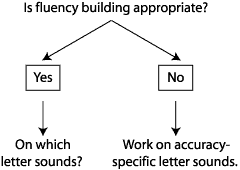Instruction

Step 1: Is Fluency Building Appropriate?
- Examine student's performance on the DIBELS Nonsense Word Fluency measure to determine whether accuracy is an appropriate target.
- Identify target goal of 50 letter sounds per minute by middle of grade 1.
- Review the following mid-Grade 1 performance patterns.
- Example A: Score of 20. All correct. No errors but very slow.
- Example B: Score of 10. 15 attempts, 5 errors.
- Example C: Score of 20. 5 errors (random errors).

Step 2: How to Develop Letter Sound Fluency: Scaffolding and Review
- Identify letter sounds students can identify accurately and include them in fluency building. Instruct students on letter sounds not identified accurately.
- Progress from accuracy to fluency by systematically decreasing the amount of time per response (3 - 2 - 1).
- Separate highly similar examples (d/b) on 1st sets.
- Include multiple examples of each letter sound in the practice set.
- Provide 2-3 short duration practice opportunities per day.
Letter-Sound Fluency Building Example: The 1-Minute Dash
- Identify a set of letter sounds student can correctly identify.
- Include multiple cards of each letter in the set.
- Set a goal (i.e., 30 letter sounds correct).
- Do a 1-minute small-group practice. Position cards so that all students can see.
- Start the stop watch.
- Present the first letter sound card so that all students answer.
- Provide quick corrective feedback on errors.
- Continue presenting letters.
- Letter-sounds correctly identified go in one pile.
- Place errors in second pile.
- At the end of 1 minute, tally the number of letter sounds correct.
- Review errors and repeat activity for 1 more minute.
Examples of Letter-Sound Fluency Activities
- Paired peer practice. Pair a higher performer with a child who needs fluency practice. Use similar procedures as in 1-Minute Dash. Each child may use his/her set of known letter sounds. (Peer-Assisted Learning Strategies Fuchs, Fuchs, Mathes, & Simmons; see References).
- Rapid response practice during instruction. Include a short review of known and newly taught letter sounds during instruction. Systematically decrease the amount of time students have to respond.

